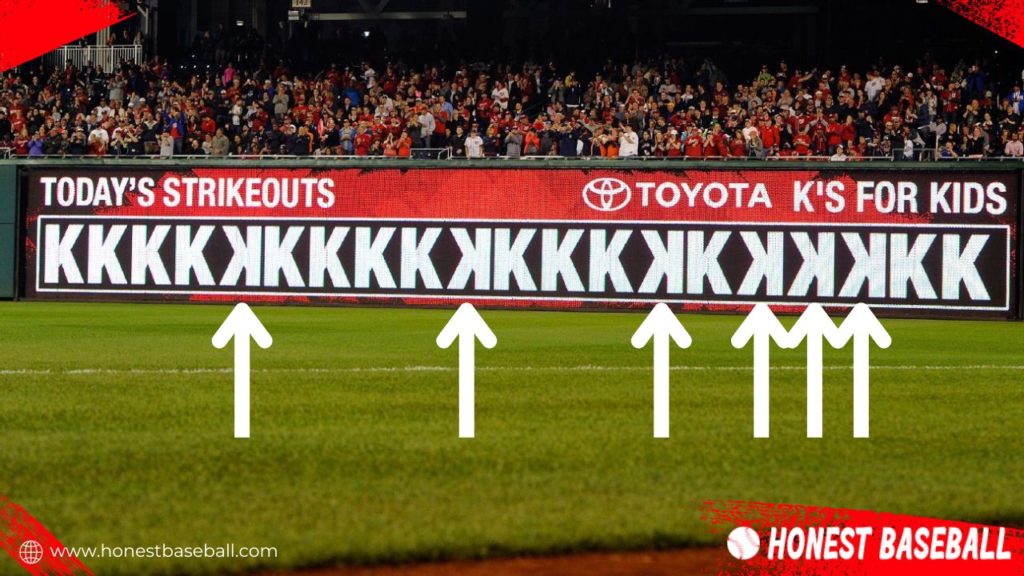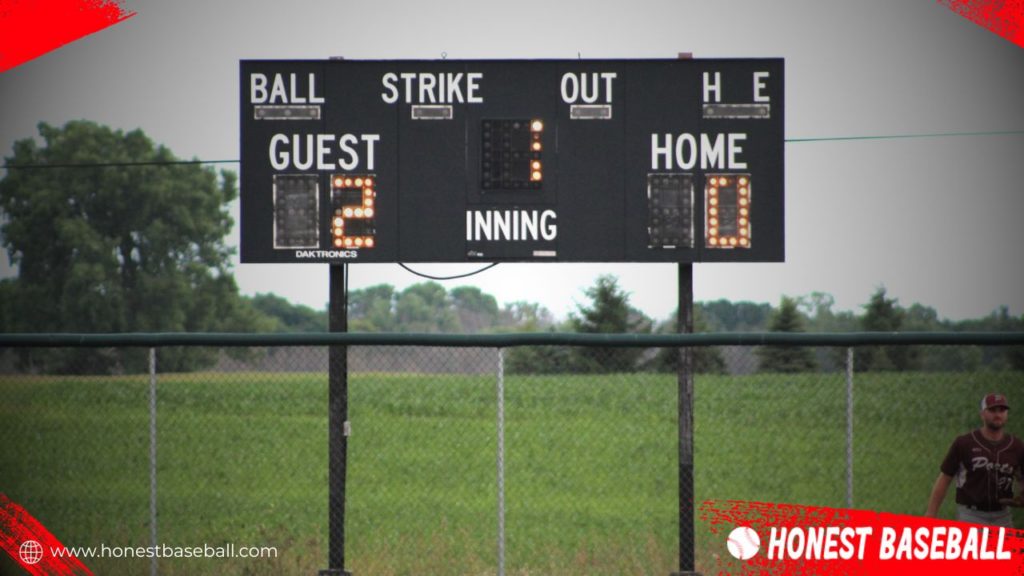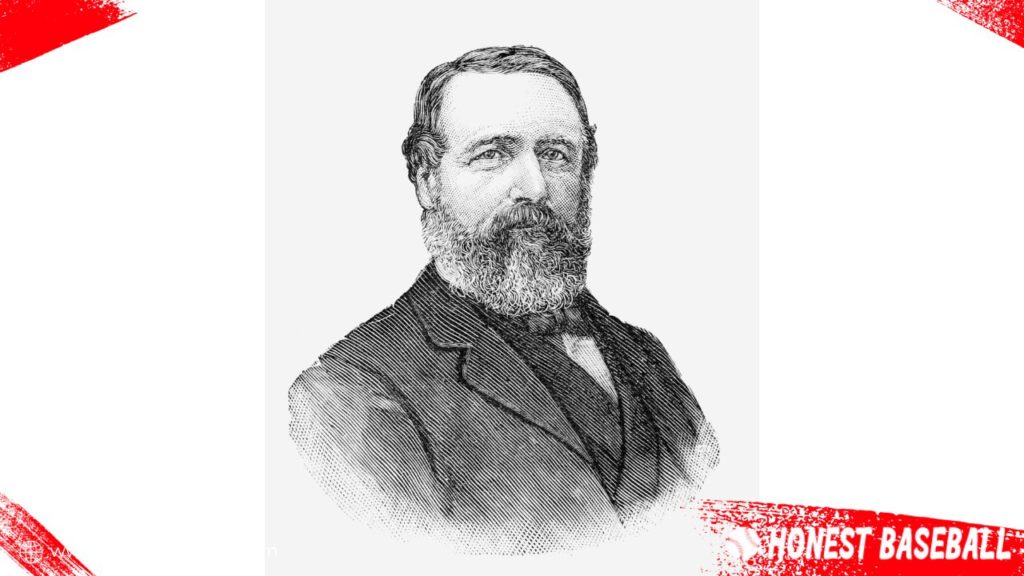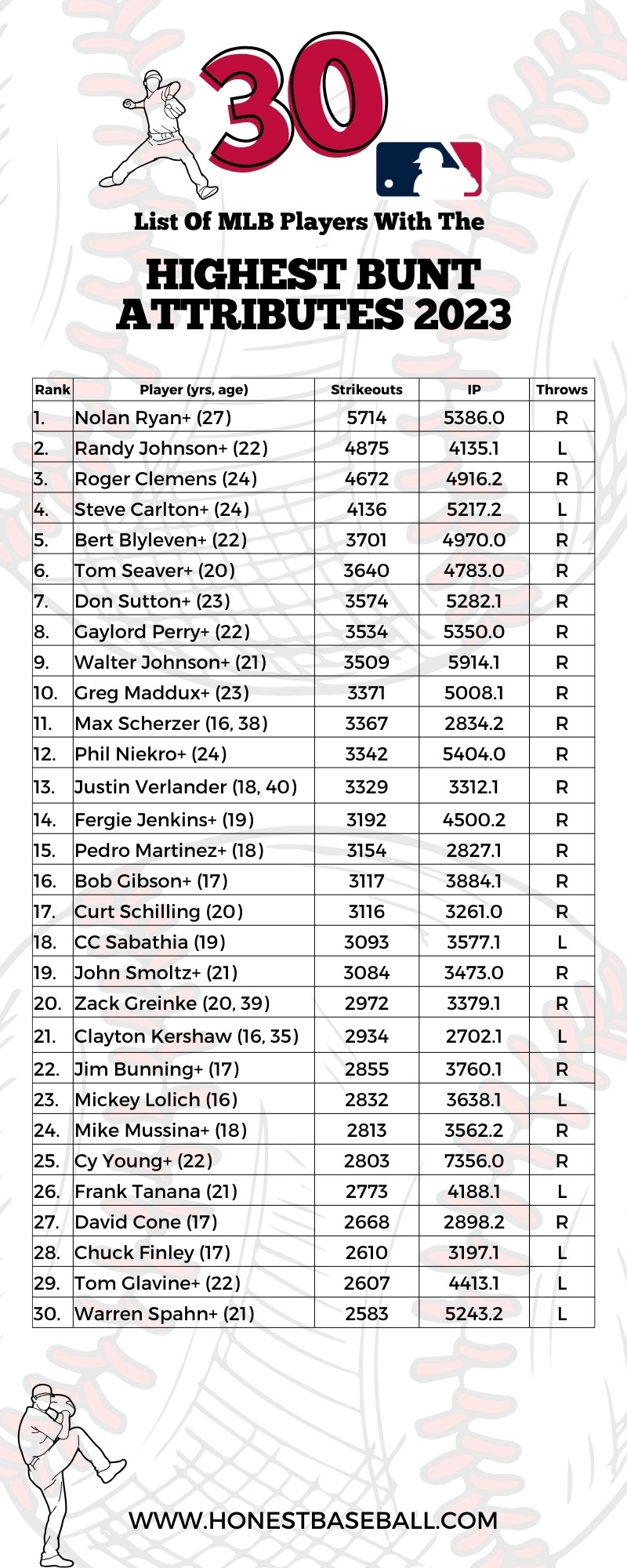The letter “K” holds a special significance in the world of baseball. It is commonly used to represent a Strikeout. And that is the reason people find it confusing and ask me what does k in baseball mean!
If you see the other common baseball terms such as BB, ERA, RBI, FPS, etc. – they all are relatable abbreviations of their full-form meaning. But this is not the case for “K“.
To find the answer, you need to explore back to the 19th century. The wise journalist Henry Chadwick has the answer for you.
“Henry Chadwick was the early originator of the baseball scoreboard and box score. He is also the only baseball hall of fame as a journalist.”
Let’s start learning deeper about the strikeout K sign meaning in the baseball scoreboard, its legacy, and all the MLB strikeout records.
What Does K in Baseball Mean?
As mentioned, in baseball, the letter “K” is a symbol that denotes a strikeout. This strikeout symbol in baseball is used to indicate that a batter was unable to make contact with the pitched ball, no matter if it’s a dropped third strike.
A batter is out on strikes or a strikeout after three pitches in a baseball game. The umpire announces either swinging strikes or called strikes depending on the game situation.
Originally in early baseball rules, a strikeout required three swinging strikes in an inning. But in 1858, the called strike was added, which brought the strikeout rule to its current form. Common baseball slang for a strikeout includes:
- Whiff
- Punch out
- Rings up
Different Types of Strikeouts
Yes, there are different types of strikeouts in baseball. Here are some examples:
- Swinging Strikeout: This occurs when a batter swings at and misses three pitches.
- Called Strikeout (Strikeout Looking): When an umpire calls three strikes on a batter without them swinging.
- Foul Ball Tip Strikeout: If a batter fouls off a pitch that is caught by the catcher and it’s their third strike, they are considered out.
Example of Using Forward K in Baseball Scoreboard
Let’s say two players named Barry and Willie are playing a baseball game. If Barry swings and misses at the third strike, the scorekeeper will add a “K” on the scoreboard beside his name. And if Willie does the same thing, it would be another “K“. So, the scoreboard for the first inning might look like this:
| 1 | 2 | 3 | 4 | 5 | 6 | 7 | 8 | 9 | R | H | E |
| Barry K | |||||||||||
| Willie K |
What Does Backwards “K” Baseball Mean?

As of now, I shared insights about what does k in baseball mean, which is a forward sign. But there is a backward symbol too. A backward “K” in baseball means the batter struck out looking.
This happens when the batter doesn’t swing at the pitch and the umpire calls it a strike. The backward “K” “ꓘ” is used when there are no runners on base or two outs already in a ball game.
Example of Using Backward K in Baseball Scoreboard
Assume if the batter, Barry, takes a called third strike in the first inning, the scorekeeper writes a backward K (ꓘ) to indicate Barry struck out without swinging. If the next batter Willie also takes a called third strike, the scorekeeper logs another backward “K” in Willie’s at-bat.
The backward K differs from a regular K in that it captures extra detail about the strikeout. While the standard K suffices to mark a strikeout, the backward K‘s directionality conveys additional context that the batter did not swing on the third strike. This nuance is useful for scorekeeping purposes.
So the backward K serves a specific scorekeeping function – succinctly noting strikeouts looking. Its reversed orientation adds useful detail not contained in the generic K symbol for strikeouts. The scoreboard might show something like this for the first inning:
| 1 | 2 | 3 | 4 | 5 | 6 | 7 | 8 | 9 | R | H | E |
| Barry ꓘ | |||||||||||
| Willie ꓘ |
Forward K vs. Backwards K: What Are the Differences?
| Forward K | Backward K | |
| Definition | A strikeout looking, when the batter doesn’t swing at the third strike | A strikeout swinging, when the batter swings and misses at the third strike |
| Notation | K | ꓘ |
| Example | Batter watches strike 3 go by without swinging | Batter swings at strike 3 and misses |
Baseball K Rules for Scoreboards

Baseball scorekeepers have developed special notations to record additional details around strikeouts. For a swinging strikeout, it can be noted as a “K-S”. But for a called third strike where the batter doesn’t swing, they may use a backward K (ꓘ), or other variations like K-L, CK, or Kc (for “called”).
While swinging and called strikeouts are equal in the game, these scorekeeping conventions allow the type of strikeout to be captured. So even though “K” alone is still used, the backward K and other “called strikeout” abbreviations provide extra context that “K” does not.
Despite these scoring customs, Major League Baseball uses “SO” as the official abbreviation for strikeout in its records. But the traditional “K” remains widely used by fans, media, and scorers due to the long history and recognition it has earned as shorthand for baseball’s strikeout.
K History with Henry Chadwick: A Pioneer in Baseball Statistics
The letter “K” has become deeply ingrained in baseball culture as the shorthand for recording a strikeout. This tradition started with early baseball writer Henry Chadwick, who is credited with inventing the box score.

In the 1850s, Chadwick decided to denote strikeouts with a “K” because the letter matched the “struck” in “struck out”. He had already used “S” for sacrifice hits, so “K” for strikeouts was a natural choice. Though never officially adopted, his intuitive scoring stuck and the “K” remains iconic today.
Over time, customs emerged around stylistic variations on the “K” to capture more detail. For example, now, a backward “K” (ꓘ) indicates a called third strike where the batter didn’t swing.
“Mets fans started placing a “K” card for each strikeout on the stadium railings as a tribute to pitcher Dwight “Doc” Gooden. ”
What is the K Rate in Baseball?
The K rate in baseball shows how many strikeouts a player or team gets. It’s used in scorecards and box scores to show the total number of strikeouts for a pitcher or batter. The K rate can tell us how well a player is doing.
For pitchers, a high K rate means they’re good at striking out batters. And for batters, a low K rate means they’re good at making contact with pitches and not getting struck out.
A Good K Rate in Baseball is
Assessing strikeout rates is an important part of evaluating pitchers in baseball. When looking at strikeout stats like K/9, it helps to know what benchmarks represent quality performance.
- Starting pitchers tend to average about 6 to 7 strikeouts per 9 innings pitched. The exact MLB average fluctuates year to year but is generally in this range. Pitchers with K/9 rates significantly above this average are considered to have high strikeout capabilities.
- Relief pitchers frequently post higher K/9 figures compared to starters. The bullpen role lends itself to going all-out for whiffs in short stints.
- Leading relievers nowadays often exceed 10 K/9. While the starting pitcher average offers a good baseline, well above that is typical for pitching out of the bullpen. The average K/9 for relievers is approximately 7.21.
In general, the higher the K/9 rate, the better for pitchers. But context like role, experience level, and opponent faced must also be considered when assessing the strikeout proficiency suggested by a pitcher’s K/9. The benchmarks help gauge expectations, but performance should be evaluated holistically.
MLB Strikeout Record Breakers in Baseball History
There have been some amazing strikeout records in the history of Major League Baseball.
Highest Strikeouts by Pitcher: Nolan Ryan, 5,714 Strikeouts
Nolan Ryan is the best pitcher ever. He played for 27 years and struck out 5,714 batters. That’s the most strikeouts ever in baseball.
Highest Strikeout by Batter: Reggie Jackson, 2,597 Strikeouts
Reggie Jackson has the record for the most strikeouts by a batter, with 2,597. Even though he got struck out numerous times, he was still a great clutch hitter.
Highest Strikeouts in a Single Season by Pitching: Matt Kilroy, 513 Strikeouts
Matt Kilroy holds the record for the most strikeouts in one season. In 1886, he struck out 513 batters while playing for the Baltimore Orioles. This record has stood for over a hundred years and no one has been able to beat it.
Highest Strikeouts in a Single Season by Batting: Mark Reynolds, 223 Strikeouts
When we talk about batters, Mark Reynolds has the most strikeouts in one season. In 2009, he struck out 223 times while playing for the Arizona Diamondbacks.
Highest “Strikeout Rate” by a Pitcher in a Season: Chris Sale, 11.06
Through 2022, Chris Sale holds the highest strikeout rate by a pitcher in a single season with an astounding rate of 11.06 strikeouts per nine innings. This means that on average, Chris struck out over 11 opposing batters for every full game he pitched during that particular season.

Frequently Asked Questions
How do fans recognize strikeouts at baseball games?
Fans at baseball games have different ways to recognize strikeouts for their supporting team. Such as:
K Signs: Fans show their support for pitchers by spelling their names with “K” for each strikeout.
“This started with New York Mets fans to honor Dwight Gooden, who was called Dr. K.”
Cheers Signs: At the Old Yankee Stadium, fans used to put up small signs to celebrate when the pitcher struck out a player on the other team.
What does the K/BB ratio mean in baseball?
To understand the K/BB ratio, you need to understand what K and BB mean in baseball. Basically, the ratio provides insight into a pitcher’s performance by revealing the number of strikeouts they achieve for every walk they concede.
This ratio is calculated straightforwardly by dividing the pitcher’s total strikeouts by their total walks (BB or Base on Balls.) It is a fundamental metric for assessing pitchers.
Why Couldn’t a Scorer Use an S for Strikeout instead of a K?
Chadwick had previously assigned “S” to signify the “Sacrifice” in a box score. Therefore, he opted for “K” to represent a strikeout, as it corresponds to the final letter in “struck“.
Conclusion
And so, the legacy of the letter K lives on in baseball’s scoring tradition. Though never officially adopted by Major League Baseball, it remains the iconic shorthand notation for the strikeout. What started as a logical shorthand by Henry Chadwick in the 1800s evolved into an indispensable part of baseball’s fabric.
When we ask “What does K in baseball mean?“, the answer is clear – thanks to Chadwick’s forward-thinking choice, K is, was, and likely always will be the terse yet vivid notation for baseball’s strikeout.
Check out more about baseball terms and scorekeeping:

Hello everyone. My name is Jason Butler, and I live in California, America. I was a professional AAA Minor League Baseball player. I lost my chance of playing MLB for injury issues, but I did not lose my love for baseball. I attended the coaching training program and am now working as a coach in a small school in San Diego.
I always love to share my experience and knowledge if that can help you. Play baseball, and stay fit.
